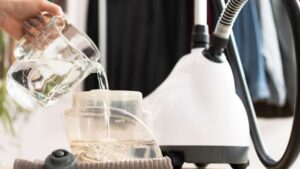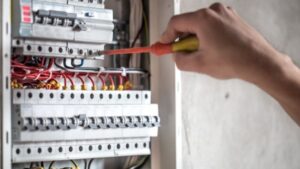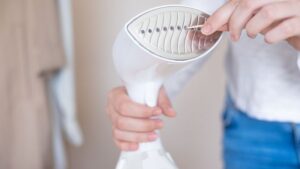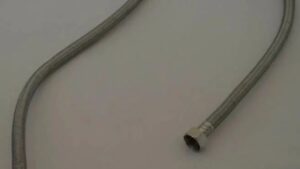Your trusty steamer is not working or has hit a snag, leaving you with wrinkled clothes and a frown. But fear not because okayreview is here to help you fix it like a pro!
We have all the tips and tactics to get your steamer back in operation, whether refusing to steam or simply not heating up.
There’s no need to contact for assistance or run to the store for a replacement. You’ll be back to enjoying wrinkle-free clothing and flawlessly steamed dinners in no time with some know-how and helpful assistance.
So, grab your steamer, and let’s dive into the world of troubleshooting to find out what’s causing the issue and how you can fix the steamer is not Working!
Table of Contents
Why is Your Steamer is Not Working?
1. Out of Steam
There might be several reasons why your garment steamer is not working. Creating steam may take more time since water must circulate through the system.
Another typical reason is a lack of water in the reservoir. Without adequate water, the steamer will not produce enough steam and may cause internal components to fail.
Check the reservoir’s water level regularly to guarantee good operation. Don’t be concerned if it doesn’t start steaming right away; this is a common element of the first setup.
2. No Electricity/Power
In the lack of electricity, your garment steamer may need to be fixed. Problems with power outlets, blown fuses, or insufficient power supply may result in the steamer not turning on or producing enough steam for efficient wrinkle treatment.
To maintain good operation, inspect the power system and prevent using extension cords or overloading circuits.
Power interruptions or variations in your location may influence the steamer’s performance.
3. Not Heating Up
After a brief wait, users must use garment steamers. Heat up effectively and create steam usually takes 45 seconds to a minute.
Some steamers include a flashing light that indicates the heating process and then turns off when it is finished.
It is critical to note that these steamers do not immediately heat up when turned on, but a small wait guarantees they perform effectively by steaming the water.
4. Strange Noise and Droplets of Condensation
Strange noises and condensation droplets signal possible problems with a garment steamer.
When droplets accumulate on the steamer’s head, and odd sounds are heard, it indicates that the steam hose inside the device is faulty.
The hose may get bent, impeding the flow of steam and interfering with the steamer’s operation.
Addressing these warning indicators as soon as possible will assist in ensuring the garment steamer’s efficient operation.
5. Limescale Buildup
Limescale accumulation is a typical problem with garment steamers. The sporadic bursts of steam may indicate a white residue inside the device.
This residue is limescale, caused by minerals liberated from the water during steaming. It is often composed primarily of calcium deposits. However, it is readily remedied.
Some steamers include a de-calcify mode that addresses this automatically, while others require manual cleaning to maintain peak performance.
6. Problem With the Steam Hose
If your steamer is not working correctly and making gurgling noises, there might be a problem with the steam line.
Using the steamer in an unintended horizontal or vertical position might cause the steam hose to bend, impeding the flow of water and preventing the steamer is not working correctly.
Ensure smooth operations and prevent such difficulties by appropriately using and aligning the steamer.
How to Troubleshoot and Fix a Steamer is Not Working?
1. Fill Up the Reservoir
 When filling the reservoir of a steamer, ensure proper alignment and look for leaks.
When filling the reservoir of a steamer, ensure proper alignment and look for leaks.
Refer to the manufacturer’s recommendations for the optimum water level, considering the size of the garment.
To guarantee steady steam flow, unclog the nozzle. For the most excellent results, use distilled water.
Fill the reservoir with water if it is empty. New goods may need relocating the reservoir. After completing these instructions, your steamer will be ready to create steam effectively.
2. Fix the Fuse
 First, thoroughly check the breaker box and insert the plug into the wall.
First, thoroughly check the breaker box and insert the plug into the wall.
If the issue persists, consider bent prongs or rust on the pin as potential causes. Straighten crooked prongs or replace the plug if needed.
If still, the steamer is not working; you may need to call customer support to repair a loose component. Replace the blown voltage fuse to restore correct operation.
3. Clean Up the Minerals
 Turn off your steamer and allow it to cool before cleaning off mineral deposits. Make a solution of 2 cups vinegar and 1 cup water.
Turn off your steamer and allow it to cool before cleaning off mineral deposits. Make a solution of 2 cups vinegar and 1 cup water.
Dip a washcloth in the solution and clean the machine from the inside out.
It is blowing dry the pieces, reassembling them, and letting them set for a few minutes before usage.
These easy methods will clear any mineral buildup and maintain your steamer in good working order.
4. Straighten Up the Steam Hose
 Consider straightening the steam hose to remedy the problem of a faulty steamer.
Consider straightening the steam hose to remedy the problem of a faulty steamer.
If you’ve determined that the steam hose is the source of the problem, return it to its original location.
Avoid leaving your vertical steamer in a horizontal position for a lengthy period, as this might impede water flow and cause steam-related issues.
Taking these actions should help restore the functioning of your steamer and assure peak performance.
5. Give Enough Time
 New steamer users must wait some time for it to start working correctly.
New steamer users must wait some time for it to start working correctly.
In contrast to instant steam generation, steamers may take 45 seconds to produce steam after being turned on.
Patience is essential for achieving excellent heating results and a pleasant user experience.
Final Thoughts
It’s simple to repair your steamer! Check the water levels, electricity source, and any potential obstructions. Give it a few seconds to produce steam, and you’ll be wrinkle-free.
Have Fun Steaming!


Your troubleshooting guide for when a steamer is not working is super helpful. I appreciate the clear, step-by-step instructions and practical solutions. This post is an excellent resource for avoiding frustration and getting the steamer back in action.